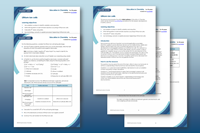Review your learners’ understanding of electrochemistry and its applications
This resource accompanies the article Better batteries in Education in Chemistry, which delves into the research developments in battery science.
Learning objectives
- Use oxidation numbers to identify oxidation and reduction.
- Write half-equations to demonstrate reactions occurring in lithium-ion cells.
- Calculate Eθ values using data.
- Use terminology correctly to explain processes happening in lithium-ion cells.
Introduction
Electrochemical cells have important commercial applications as portable electricity supplies to power electronic devices such as mobile phones, tablets and laptops. Rachid Yazami and John B Goodenough played a key role in the development of rechargeable batteries such as lithium-ion cells.
Investigate batteries further with the 2022 global experiment
Perfect for your younger learners, Take charge: a global battery experiment gives them the opportunity to build and test their own coin batteries, as well as exploring how they can help build a more sustainable future. It’s so easy, get started today.
The cathode in a lithium-ion cell is made of lithium cobalt oxide (LiCoO2) and the anode is made of graphite (C). Oxidation always occurs at the anode (AN OX) and reduction at the cathode (RED CAT). The batteries can be charged and discharged. This relies on the movement of lithium ions in the electrolyte through a semipermeable barrier and electrons in an external circuit. Over time, the battery performance decreases from repeated insertion of lithium ions into the graphite structure.
How to use the resource
The questions may be used at the end of the topic, either in class or as homework, to reinforce understanding of electrochemical cells and identify misconceptions. Hints are provided for some questions to aid differentiation. Answers to all questions are available in the teacher notes.
Questions 1, 2, 4, and 6 test recall of definitions, task learners to work out oxidation numbers and perform simple calculations.
Questions 3, 7 and 8 require learners to apply their knowledge to deduce half-equations at the relevant electrodes, make links to the electrochemical series and construct the lithium-ion cell notation.
Question 5 enables you to check learners’ understanding of terminology and correct any misconceptions around the use of keywords and process in electrochemistry.
More resources
- Watch the practical video, carry out the microscale experiments and use the supporting resources to help learners investigate and apply the principles of electrochemistry.
- Meet Liz, a PhD researcher investigating new materials for lithium-ion batteries to improve their performance in technology.
- Get your 16–18 learners practising calculations and predicting reactions using EƟ values with the Redox equilibria starter for 10.
- Provide context to life-cycle assessments when teaching your 14–16 learners with this worksheet on lithium-ion batteries and the issues surrounding their manufacture and disposal.
Downloads
Lithium-ion cells student worksheet
Handout | PDF, Size 0.21 mbLithium-ion cells teacher notes
Handout | PDF, Size 0.23 mbLithium-ion cells student worksheet
Editable handout | Word, Size 0.45 mbLithium-ion cells teacher notes
Editable handout | Word, Size 0.45 mb



















No comments yet